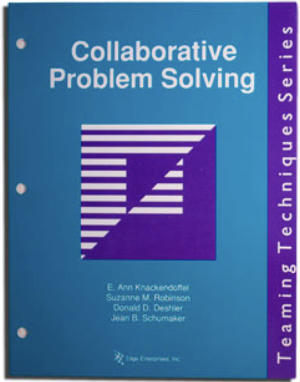Collaborative Problem Solving

The key to solving shared problems relies, in large measure, in the communication skills of the people associated with those problems. Although designed specifically for use in educational settings, Collaborative Problem Solving outlines the communication skills needed to solve problems within any group. These skills include listening actively, reflecting another person’s statements back to that person, asking questions, and summarizing. The skills are then incorporated within a problem-solving process that can be used to structure meetings between two or more people, especially those working together to support specific students. Numerous examples of this process are presented throughout the book, as are opportunities to practice the skills.This process is appropriate for any educator, parent, or person interested in improving communication while working with others to help students succeed. It is especially useful for teachers in cooperative teaching relationships and in collaborative relationships between general and special educators.
Teacher or Student Feedback on Collaborative Problem Solving
Co-Author Ann Knackendoffel says, "The response from teachers in the field has been very supportive. They have been much more visionary than I was when I first created Collaborative Problem Solving and found a multitude of uses for the model beyond just their collaboration with general and special education teachers. They have found the process helpful with working one-on-one with colleagues, but they have been most enthusiastic about how it helps when they have multiple participants in a meeting such as a student improvement or IEP meeting. Teachers have also reported it useful when they are meeting with parents or working with students. They find the Problem-Solving Worksheet keeps them on task and focused on the problem rather than straying off into areas that detract from solution finding."
Author(s):E. Ann Knackendoffel, Suzanne M. Robinson, Donald D. Deshler, and Jean B. Schumaker
Publication Info: Edge Enterprises, 1992
The Story Behind Collaborative Problem Solving from author Ann Knackendoffel:
As a special education teacher, I knew that I was a key component in making inclusion work in my school and ensuring the success of students with special needs. Problem solving was required daily in my role as a special educator but none of my training to become a teacher prepared me to work with other adults, especially when we saw problems through different lenses. When my colleagues and I began to look at how general education and special education teachers problem solve, we learned that they too lacked training in effective strategies for working with others, problem solving, and negotiating in the professional arena of schools.
Increasingly, educators are recognizing that the needs of students who are at-risk for academic and social failure can best be met if professionals work together as teams in designing and delivering educational programs. Many times, the problems of these students are complex and go beyond the expertise of one professional. A team of professionals is often needed to clearly understand the needs of students, and, in turn, specify appropriate actions to be taken. While there are many collaboration skills that are needed for teams to be successful, collaborative problem solving seems to be at the heart of teaming. Without this foundational skill, teams often find that their valuable meeting time is less effective and efficient than it could be.
As my colleagues and I watched many teachers problem solve, we realized the most productive collaborative relationships were characterized by mutual respect, trust, and open communication. It did not serve the students or the teachers well if one person took on the problem without the true collaboration and input of others. We developed Collaborative Problem Solving to guide teachers in this process and to give them the tools they needed to be successful in their problem-solving efforts. We drew on the work of many effective problem-solving models but then tailored them to meet the unique framework of special and general education teachers working together. We listened to the feedback of teachers who implemented Collaborative Problem Solving, and, through our field tests with many teachers, we learned what worked and the parts that needed refinement before the final product was published. We think we came up with a product that has stood the test of time and that is a useful tool for teaching partnerships or larger school-based teams such as teacher assistance teams or school improvement teams.
Author's Thoughts about Strategic Instruction:
When I was first introduced to strategic instruction over 25 years ago, I knew it made both intuitive sense and was supported by good research.
Teacher or Student Feedback on Collaborative Problem Solving:
The response from teachers in the field has been very supportive. They have been much more visionary than I was when I first created Collaborative Problem Solving and found a multitude of uses for the model beyond just their collaboration with general and special education teachers. They have found the process helpful with working one-on-one with colleagues, but they have been most enthusiastic about how it helps when they have multiple participants in a meeting such as a student improvement or IEP meeting. Teachers have also reported it useful when they are meeting with parents or working with students. They find the Problem-Solving Worksheet keeps them on task and focused on the problem rather than straying off into areas that detract from solution finding.
Available from Edge Enterprises, Inc.